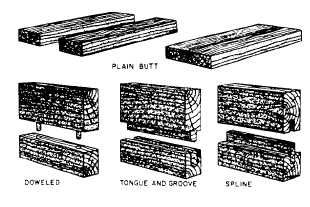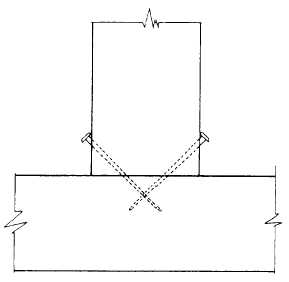millwork. Of the edge joints shown in figure 3-50, the dowel and spline joints are used mainly in furniture and cabinet work, whereas the plain butt and the tongue-and-groove joints are used in practically all types of woodworking.
The joints used in rough and finished carpentry are, for the most part, simply nailed together. Nails in a 90° plain butt joint can be driven through the member abutted against and into the end of the abutting member. The joints can also be toenailed at an angle through the faces of the abutting member into the face of the member abutted against, as shown in figure 3-51. Studs and joists are usually toenailed to soleplates and sills.
The more complex furniture and cabinet-making joints are usually fastened with glue. Additional strength can be provided by dowels, splines, corrugated fasteners, keys, and other types of joint fasteners. In the dado joint, the gain joint, the mortise-and-tenon joint, the box corner joint, and the dovetail joint, the interlocking character of the joint is an additional factor in fastening.
All the joints we have been mentioned can be cut either by hand or by machine. Whatever the method used and whatever the type of joint, remember: To ensure a tight joint, always cut on the waste side of the line; never on the line itself. Preliminary grooving on the waste side of the line with a knife or chisel will help a backsaw start smoothly.
Half-Lap Joints
For half-lap joints, the members to be jointed are usually of the same thickness, as shown in figure 3-43. The method of laying out and cutting an end butt half lap (figure 3-43) is to measure off the desired amount of lap from each end of each member and square a line all the way around at this point. For a corner half lap (figure 3-43), measure off the width of the member from the end of each member and square a line all the way around. These lines are called shoulder lines.
Next, select the best surface for the face and set a marking gauge to one-half the thickness and score a line (called the cheek line) on the edges and end of each member from the shoulder line on one edge to the shoulder line on the other edge. Be sure to gauge the cheek line from the face of each member. This ensures that the faces of each member will be flush after the joints are cut.
Next, make the shoulder cuts by cutting along the waste side of the shoulder lines down to the waste side of the cheek line. Then, make the cheek cuts along the waste side of the cheek lines. When all cuts have been made, the members should fit together with faces, ends, and edges flush or near enough to be made flush with the slight paring of a wood chisel.
Other half-lap joints are laid out in a similar manner. The main difference is in the method of cutting. A cross half-lap joint may best be cut with a dado head or wood chisel rather than a handsaw. Others may easily be cut on a bandsaw, being certain

Figure 3-50.-Edge Joints.

Figure 3-51. - Toenailing.
Continue Reading